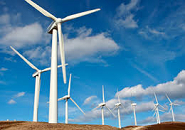Environment and Energy

Offshore Energy Goal Faces Serious Headwinds: IHS
Written by Tim Triplett
August 3, 2021
U.S. offshore wind energy is expected to grow rapidly, but bottlenecks in the market and a crucial lack of infrastructure mean that President Biden’s optimistic offshore wind target of 30GW by 2030 will almost certainly be missed, reports IHS Markit. Wind towers are a promising growth market for steel plate.
IHS Markit expects U.S. offshore wind installed capacity to reach 21GW by 2030, up from just 42MW at present, resulting from more than $100 billion to be invested in the industry in the next nine years. This would represent impressive growth in the U.S. share of the global total installed offshore wind capacity, from close to zero to around 9% in 2030.
Bottlenecks Make 2030 Target Unattainable
Complex and lengthy permitting processes combined with a lack of manufacturing facilities, a shortage of specialized installation and service vessels, plus poor power transmission infrastructure are key bottlenecks hampering more rapid spread of wind power. The impact of the COVID-19 pandemic has been a further impediment, IHS noted.
Costs for offshore wind remain high compared to other carbon-free generation resources. Current unsubsidized costs for bottom-fixed and floating offshore wind projects are estimated at $125 per MWh and $225 per MWh, respectively – well above wholesale electricity prices and costs for both onshore wind and solar PV. While costs are expected to decline sharply in the coming decades and the cost gap between bottom-fixed and floating is expected to narrow, offshore wind will remain a relatively expensive resource.
“Looking beyond the levelized cost of electricity (LCOE), offshore wind offers alternative benefits over less-expensive onshore wind and solar PV, including higher capacity factors and greater capacity value. Onshore wind and solar PV are increasingly constrained by availability of land, particularly in the U.S. Northeast and Mid-Atlantic. Moreover, offshore wind projects are located close to load centers, generating large volumes of clean electricity for major coastal cities,” said Andrei Utkin, principal analyst for Clean Energy Technology at IHS Markit.
Infrastructure Investment Lays Path for Growth
The Biden administration’s 2030 target aims to significantly promote the build-out of the domestic offshore wind fleet, driving capital investments and providing job opportunities. The plan aims to speed up project permits, including environmental reviews, and provide $3 billion in public financing for offshore wind projects through the Department of Energy.
Investment of more than $500 million is planned for port upgrades including reinforcing and modernizing port infrastructure and supporting shore-side wind energy activities, such as storage areas, laydown areas, and docking of wind energy vessels to load and move items to offshore wind farms. The sector will be further bolstered by plans to build four to six new wind turbine installation vessels in U.S. shipyards, each representing an investment of $250-500 million.
Additionally, the 30% investment tax credit (ITC) extension will provide a major boost for projects that start construction by the end of 2025 and come online as late as 2035.
Vast Investment Opportunities After Initial Hurdles
Due to the lack of an established offshore wind supply chain in the U.S., turbine components for the first commercial projects will be mainly sourced from mature European markets until OEMs invest and open up local manufacturing facilities. Pioneer arrays will also be installed by European installation vessels with the support of Jones Act-compliant U.S. feeder vessels.
However, the offshore wind sector offers a multitude of attractive investment opportunities into dedicated supply chain, manufacturing and port facilities, transmission grids, and installation and service vessels, IHS said.
At least $2.5 billion in investments have so far been announced in a variety of projects. These include infrastructure upgrades, ports and factories for foundations, towers, blades and cables, and the first offshore wind nacelle assembly facility by GE Renewables that will assemble nacelles for the 1148 MW Ocean Wind 2 project off the coast of New Jersey.
“Over time and with scale, as more and more offshore wind farms in the United States are approved, equipment manufacturers will be more willing to invest and build local supply chains and new installation vessels. But it will be a gradual process as the industry needs to see a rich pipeline of consented projects and a clear regulatory framework before committing to invest billions of dollars in local factories,” Utkin said.

Tim Triplett
Read more from Tim TriplettLatest in Environment and Energy

June energy market update
In this Premium analysis we examine North American oil and natural gas prices, drill rig activity, and crude oil stock levels. Trends in energy prices and rig counts serve as leading indicators for oil country tubular goods (OCTG) and line pipe demand.

EPA deregulation proposals win praise from steel advocates
Two industry groups are applauding two EPA proposals that would support domestic steel production.

Met coal receives critical materials status
The US Department of Energy (DOE) adds metallurgical coal to the nation’s list of Critical Materials, following its designation by US Secretary of Energy, Chris Wright’s announcement on May 22.

May energy market update
An analysis of the North American energy market in May.

House committee blocks GOP budget proposal
The budget proposal has big implications for steel and manufacturing.
